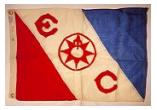Flag Expeditions
Every year Explorers Club members launch new research expeditions around the world, thus continuing the early goals laid down by the Club's founders in 1904. The Explorers Club flag represents a history of courage and accomplishment and has been carried on hundreds of expeditions since 1918. Flag expeditions fulfill a fundamental part of the Club's mission: To engage in scientific exploration and share the results.
Into the Field
New flag expeditions are launched throughout the year. View a list of approved flag expeditions, as our members carry the flag into new terrain and uncharted waters. 3YØX DXpedition Team member and Explorer Club Member Al Hernandez, K3VN secured permission to take Flag #176 to Peter I.
Flag Reports
Any member of the Club approved to carry the flag on an expedition is required upon return to issue, in hardcopy, an official Flag Report. These reports fulfill a fundamental part of the Club's mission, to engage in scientific exploration and share the results.
Flag Interviews
Throughout the history of the Club, our members have shared the results of their flag expeditions upon return from the field. Now for the first time explorers.org will bring you communications from the field, while an expedition is in progress.
Carrying the Flag
Any member in good standing may apply for the privilege of carrying the Explorers Club flag on an expedition intended to further the cause of exploration and field science. The flag has been carried on hundreds of expeditions since 1918: to both poles, to the highest peaks of the greatest mountain ranges, to the depths of the ocean, and to outer space.
The Explorers Club flag represents an impressive history of courage and accomplishment and has been carried on hundreds of expeditions by Club members since 1918. To carry the Club flag is an honor and a privilege. It has flown at both poles, from the highest peaks of the greatest mountain ranges, traveled to the depths of the ocean, to the lunar surface, and outer space. A flag expedition must further the cause of exploration and field science.
 |
An early flag featured a four-pointed white star with the name Explorers Club in the middle, all on a red silk field. It is believed that the first member to carry the flag on an expedition was the zoologist Theodoor de Booy, who journeyed to Venezuela about 1918.
|
The current flag was designed by Frederick S. Dellenbaugh, one of the Club's founding members. Between the red of courage and the blue of fidelity lies a broad white diagonal displaying the initials of the Club's name and a compass rose, symbolizing the worldwide circle of the Club's interests. The first members to carry the new flag were Clyde Fisher and Carvath Wells, who journeyed to Lapland in 1924 while leading an astronomy expedition for the American Museum of Natural History.
|
Today there are 202 numbered flags, each with its own history. Many of the older flags have been retired. A select handful of these retired flags are framed and displayed at headquarters in New York City, including the flags carried by Roy Chapman Andrews, Bob Bartlett, Thor Heyerdahl, Naomi Uemora, and the miniature flag carried by the astronauts onboard Apollo 11. |
 |
Club members who are planning scientific expeditions are encouraged to apply for the honor of carrying the flag. Instructions and application form are available to members only.
Use of the flag is governed by stringent standards. To obtain permission to carry the flag, a Club member must show that the expedition holds the promise of scientific results. The flag must be exhibited at every suitable opportunity on the expedition, and must be returned to the Club along with a written record of the expedition, called the Flag Report. The Club's Research Collections is the repository for these unique reports, including the original "Flag Book"-a bound journal of handwritten reports, vintage prints, clippings, and assorted records submitted by the explorers who first carried The Explorers Club flag on expeditions. As submission of reports in electronic format, along with hardcopy, becomes more common, Flag Reports are gradually being made available on the web. To the individuals who have carried it, the flag stands as a reminder of the dignity of the Club and of the high standards it expects of its members.





